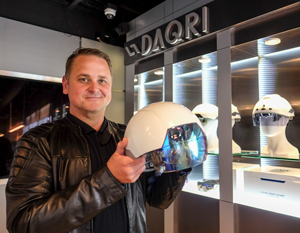L.A.’s virtual reality startups snag most of the headlines, but many in the local tech industry have turned their attention toward augmented reality, reflecting a national trend of increased investment and interest in the technology.
While high-grade VR headsets and accessories have made wondrous advances in the past five years, steep prices have kept consumers from embracing the medium, opening the door for augmented reality products that can often be used in mobile apps.
Virtual reality, which renders a computer-generated simulation of three-dimensional images that can represent actual places or imagined worlds the user can interact with, differs from augmented reality, which overlays computer-generated images and information on real environments.
“The applications of AR are endless,” said Adam Lilling, managing director of Culver City’s Plus Capital, which partners with celebrities to invest in startups. “It gives you superpowers in this reality, versus taking you out of reality and putting you in an immersive headset.”
Lilling said he’s noticed an uptick in augmented reality investment among his firm’s clients over the last year or so, adding that he’s a bigger fan of AR versus VR technology.
Kevin Winston, chief executive of tech networking group Digital LA, cited a similar increased interest in augmented reality after last summer’s global mobile game phenomenon Pokémon Go, which took players to real-life locations in search of Pokémon characters.
“I’ve talked to people who have AR startups who say that ever since Pokémon Go, it’s easier to get an investor meeting. People know what AR is,” Winston said.
Some local firms have already cashed in. For example, Culver City’s 8i Studios announced in February that it had raised a $27 million Series B round of funding led by Time Warner Inc. An AR app by 8i allows users to overlay holograms of celebrities into videos recorded on mobile phones. Nationally, venture capital firms and corporate investors poured $2.3 billion into virtual and augmented reality startups last year compared with the roughly $700 million invested in 2015, according to Menlo Park digital media consultancy Digi Capital, a nearly 230 percent spike.
Corporate tech giants are also trying to get some skin in the augmented reality game. Apple Inc. has reportedly been aggressive in its efforts, which include the development of digital spectacles that can connect wirelessly to an iPhone and beam content to the wearer. Apple also acquired New York augmented reality startup Flyby Media Inc. last year.
Consumer adoption
A recent survey by New York research firm eMarketer found that 40 million people will engage with some form of augmented reality at least once a month this year, with that number rising to more than 54 million by the end of 2019. Virtual reality will take longer to catch on, according to the report, with only about 22 million U.S. monthly users predicted in 2017.
The projected augmented reality user total for this year would represent a more than 30 percent increase over last year, fueled largely by Snapchat maker Snap Inc. of Venice and rival Facebook Inc., whose apps rely on camera-based augmented reality features to draw in users.
Enterprise AR firms have also noted the industry is picking up steam.
Roy Ashok, chief product officer for downtown’s Daqri, founded and helmed by Brian Mullins, said the AR venture has seen significantly higher advance interest in its newest product, Daqri Smart Glasses, shipping later this year, than in its Smart Helmet, unveiled in the fall. The helmet, which sold for $15,000, is a hard hat with retractable lenses designed to help technicians in industrial settings. The lighter-weight glasses cost $5,000.
Ashok said both products can be particularly helpful in training workers to perform a task, saying the glasses are more appropriate for architecture, engineering, and medical applications that do not require hard-hat protection. Unlike a VR device, which might present the worker with a simulated object in a simulated environment, the glasses allow a worker to perform a task on a simulated object in a real environment.
“You can walk into a factory and practice training on the machine itself,” said Ashok, who used as an example a technician learning to service a gas turbine or jet engine, correcting a simulated problem on an actual machine.
Despite growing engagement with AR products among Americans, Ashok said it would take a long time for consumer-facing technology to reach the level of business-focused applications such as those developed by Daqri.
“Really good displays and optics not only see the world in real time, but also have to display content in that world,” he said. “And it has to be displayed in a natural way, so that your brain and eyes can process without fatigue and stress.”
So far, he said, that type of computing power still requires a sophisticated headset.
“These are not consumer devices, they are for very specific problems in industry,” he said of Daqri’s helmet and glasses. “I wouldn’t want to comment on the timing of consumer AR. The technologies are converging, but it’s certainly not today.”

